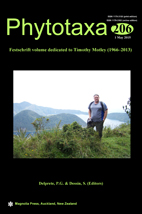Abstract
Carajasia is described as a new genus of Rubiaceae. It is so far known only from the mountain summits of Serra dos Carajás (Pará, Brazil), where it is part of a shrubby vegetation surrounded by tropical rainforest. The new genus belongs to the tribe Spermacoceae and is positioned within it to the Spermacoce clade. Carajasia is unique within the clade in having a very particular combination of characters: flowering branches with two axillary flowers per node, homostylous flowers, corollas with a fringe of moniliform hairs, pubescent styles with distinct stigma lobes, bilobed nectariferous discs covered by triangular papillae, pollen with a double reticulum and fruits with a peculiar type of dehiscence. A detailed description of Carajasia is presented, including observations of the fruit and pollen, along with distribution maps and images of the plant in its habitat. A dichotomous key to distinguish Carajasia from other genera with deeply divided stigmas is provided. A molecular phylogenetic study was carried out using ITS and ETS sequences to determine the phylogenetic position of the new genus within the Spermacoce clade. The results of the combined analyses demonstrated that Carajasia is sister to Galianthe with moderate to high support. Both genera form a weakly supported clade with Schwendenera. This clade is sister to the other genera of the Spermacoce clade studied in this work. Galianthe and Schwendenera share with Carajasia pollen with a double reticulum, but they are clearly differentiated by suffruticose habit, heterostylous flowers and the pattern of fruit dehiscence. To clarify the phylogenetic position of Carajasia, some morphological characters are discussed based on the molecular results: division of the stigma, pollen types and floral syndrome.

